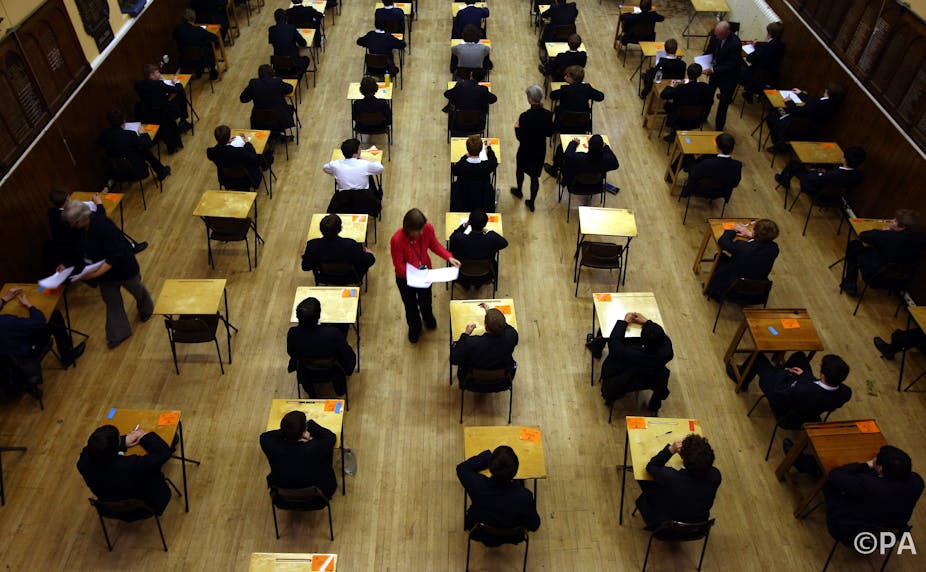The number of students entered for a GCSE exam a year early plummeted by 40% this summer. Before 2014, the number of students taking their exams in Year 10 rather than Year 11, particularly in English and mathematics, had been steadily increasing.
The reason behind the colossal drop in exam entry tells us a lot about how teachers have responded in the face of the accountability measures against which their schools are now assessed. But in recent interviews with maths teachers, I’ve found that some are in favour of the changes, which they see as giving children more time to learn.
In September 2013, Michael Gove, then secretary of state for education, announced that only a student’s first GCSE entry attempt would count towards school league tables. These tables rank schools based on how many of their students gain grades A* to C in a selection of GCSE subjects. The aim was to cut the number of early entries, amid concerns that such strategies weren’t in the best interests of some students.
Come summer 2014 and the provisional early entry figures published by Ofqual were in stark contrast to the previous year. For example, the number of students choosing to take their mathematics GCSE early dropped from 166,000 in 2013 to 31,000 in 2014. The question is whether the change is welcome or not.
A matter of strategy
Earlier this year, I carried out interviews with a group of 14 mathematics teachers, discussing how they approached entry strategies for their GCSE students. While it would be unfair to generalise from findings based on such a small group, they provided interesting insights into how changes in education policy affect teachers and students.
Before the policy change, the majority of teachers that were interviewed described how the pressure to achieve results, particularly around the grade C threshold, had driven behaviour in their schools. Teachers reported employing a range of strategies to maximise results.
These included entering students for exams early, on multiple occasions or with multiple exam boards, with a strategic focus on students hovering between getting a grade C and a grade D. Others concentrated their teaching on topics that were likely to appear in exams. Another strategy was “setting” students into ability groups targeted at achieving a particular grade and then moving students between groups after each examination attempt.
Teachers were frustrated by the constant pressures to balance the imperative to achieve results with the desire to support effective teaching and learning. They felt their hands were being forced into adopting strategies around when to enter students into exams and what to teach them, causing them considerable unease. Students could simply switch off and lose motivation if they were entered for exams repeatedly, particularly once they had achieved a grade C.
Then came the announcement that only a student’s first entry attempt would count towards school performance measures, a policy that was intended to discourage any inappropriate use of early and multiple exam entry. It appears to have succeeded.
Now the majority of students will take their GCSEs at the end of Year 11. While this might seem to increase the pressure on teachers to maintain results, those I interviewed largely spoke of a sense of relief at the change. They see the move to single exam entry as enabling far more time for classroom teaching, removing extended revision periods and time spent sitting exams. This allows teachers more time to teach effectively that is felt will help create better mathematicians.
A happy ending?
So this sounds like a positive news story. But before we accept this as a successful policy, it’s worth thinking about the other potential consequences of this change. Some teachers suggested it could penalise disadvantaged or less confident students, who often needed the boost that early exam entry could give them.
For some students, seeing they could achieve a grade in Year 10 helped spur them on to achieve more. Additionally, where early entry was used to support progression from foundation to higher tier exam papers, students in the future might remain on foundation tier where achievement is capped at a grade C.
A move to single exam entry at GCSE does seem to have done away with some “undesirable” strategies, but it’s only one part of a many faceted whole. There may be unforeseen consequences further down the line, and the picture becomes even more unclear in the face of enormous reforms and policy shifts taking place in education today.
These centralised reforms can filter down to the grass roots in unexpected ways, so it’s important that students don’t emerge as the losers in administrative overhauls.

